Like Dr. Scot McKnight, I was raised in a church that prayed spontaneous prayers–almost exclusively–unlike many churches where written prayers and recited prayers proliferate.
I can recall my mother, who was often among those who prayed aloud during worship, being asked after church for a copy of her prayer. She was always surprised, and had to disappoint everyone who made such a request, as she simply prayed from the heart, spontaneously.
 But (again like McKnight) I have long since discovered great depth and breadth and height of blessing in praying–as he puts it–not only "in" the church but also "with" the church, by means of fixed-hour prayer and the many prayer aids of the historical church.
But (again like McKnight) I have long since discovered great depth and breadth and height of blessing in praying–as he puts it–not only "in" the church but also "with" the church, by means of fixed-hour prayer and the many prayer aids of the historical church.
That’s why I love–and recommend–McKnight’s book, Praying With the Church: Following Jesus Daily, Hourly, Today.
After an introductory chapter that employs a great word-picture that is then sustained throughout the book, the first section of Praying With the Church profiles the prayer life of Jesus and makes the case for praying with him in "sacred time," "sacred terms," "sacred rhythms," "sacred prayers" and "sacred tradition."
The second section offers an overview of the major prayer books of Roman Catholic, Orthodox and Anglican traditions, along with the more ecumenical (and my go-to prayer aid) The Divine Hours, by Phyllis Tickle.
He gives an overview, sampling the structure and prayers of each, and very helpfully lays out the best–and less-than-best–parts of each one. I was surprised that my familiarity with all but one of these resources didn't lessen my interest in and enjoyment of these chapters; they were as delightful as if I were encountering the information for the first time.
A concluding chapter lays out McKnight's nine suggestions for ways everyone, no matter how busy or changeful their schedule, can pray with the church.
I recommend this book to you, whether you have discovered the rhythms and benefits of daily fixed-hour prayer or not, whether you are desperate or merely curious about deepening and broadening your prayer life, or whether you are simply looking for a good book to read.
I truly believe you won’t be sorry, as I have experienced what the author says on page 2: "Nearly everyone who practices a sacred rhythm of praying finds it life-shaping."
How about it? Have you prayed exclusively spontaneous prayers? Have you ever experienced or practiced fixed-hour praying? Why or why not?




